#caudal posts
Explore tagged Tumblr posts
Text
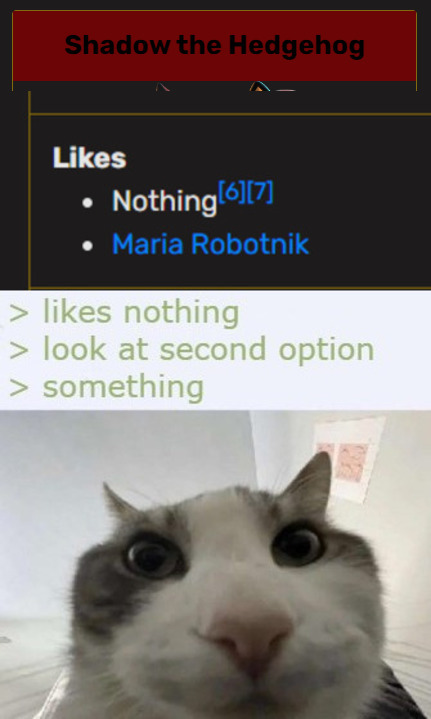
894 notes
·
View notes
Text
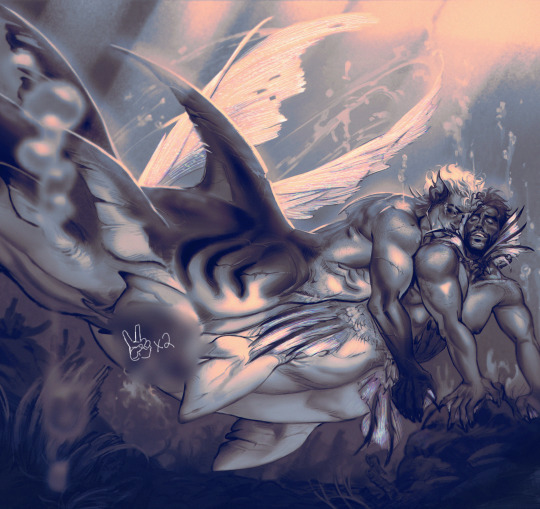
a com for mermay, my first ever time contributing 🙊 see uncen here on twt detail/full zoom under cut, it's my fav johnny face now! 🥰
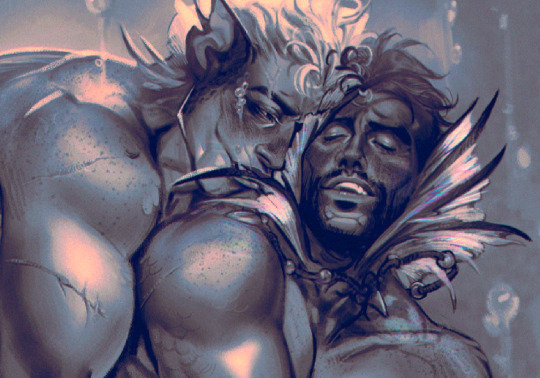

#simon ghost riley#john soap mactavish#ghostsoap#ghoap#mermay#mw#my art#johnny is based off a beluga whale purely bc of the leg post about them being mermaids to confused sailors#simon is just a borin great white i just wanted him to be massive#think i said it on twt but its supposed to be like an aristocrat to thief type comparison. frilly n fancy v practical#ghost's caudal is about the size of soap's upper torso into his pec fins as a treat for the size diff lmao
289 notes
·
View notes
Text
One day we will research Regalecus glesne . Together.
#wordstag#The lack of information on (giant) oarfish actually drives me mad did you know that. I want to see her house and what she eats for dinner#I want to see her have sex 😪#Post prompted by an oarfish I saw w/ a caudal fin and while like. Maybe they do. I wouldn't know. But like I dont think they have those#And its sooo absurd because we have freaky caudal fin going on then we have FREAKY FAKE PICTURES GOING ON??#its actually wild how popular those VERY CLEARLY PHOTOSHOPPED pictures are. We can do better than this guys.
2 notes
·
View notes
Text
bitches out here being polytocous
#maple posts#animal anatomy jokes#i cannot take this class seriously sometimes#top 10 professors who say 'bitch' and 'penis' and 'erection' with no problem but start giggling when they say 'dogs sniff each other's butt#'dogs sniff each other's... their... posterior... caudal region....'#sir you can say butt it's allowed
3 notes
·
View notes
Text
♥︎The beauty beneath♥︎
Word count: 2.4K
Warnings: slightly suggestive (I'm sorry they're not fucking like cats and dogs yet 😭)
Part 1, Part 2
Thank you thank you thank you to everyone who read the first part of this ❤️ I was so scared to post it as I'd only ever written small smut stuff but I received so much love it made me want to keep going 💗
Tags: @djstinkyfartz @orphicsun @never-rune @alorixy (if anyone wants to be tagged in upcoming parts let me know 🥰)

Hours seemed to pass by in a flash, mostly you drilling Sevika with questions. Humans were weird; I mean, who doesn't hunt their food? They can just go into something called a 'shop' and buy it? "Yes, peach, we go into the shop and pick out what food we want to eat, and then we buy it, which is why we work so we can afford it," Sevika said in response to your completely dumbfounded expression. It was entertaining at first, seeing you all confused. But the longer Sevika looked at your furrowed brows and the way your lips slightly pouted when you were confused, she couldn't help but feel an intense fluttering in her stomach. No. She couldn't—she shouldn't feel this way. She was a tough woman; she doesn't fall in love.
"But then how do you know what you're buying is trustworthy if someone else made it? That's just stupid," was your response. You held the edge of the building, propping your arms up to get a better look at Sevika, unbeknownst to her. (Or so you thought. Sevika noticed the way you continued to get closer and closer as the minutes passed.) "Don't you worry your pretty little head about it peach, we just do things differently. That's what makes it interesting, hm?" That earned a huff from you, but in the end, you decided to drop it. Your eyes met; each time they did, it felt like the world stopped. Her grey eyes bored into yours with an intensity you'd never felt before. Your grip on the building grew stronger; the cold metal beneath your fingertips was numbing, but it didn't matter. Not when she was here and in front of you. Silent words were spoken, an understanding of feelings. Shared feelings, but what exactly was it? Interest? Love? Fascination? You didn't really want to think about it, yet it was all you could think about.

God, those eyes... Sevika held eye contact, something she usually despised. She always thought it felt like people could see straight into your soul, and yet here she was, staring into your eyes that felt like they drew you in, hypnotic almost. Vulnerable, that's what Sevika felt, and she hated it. The usually cold, stoic, and quite frankly emotionless woman she was, was nowhere to be seen tonight. She wanted you to see her; she wanted to tell you her deepest secrets and dreams, and all it took was looking into your eyes. Eventually, she blinked a couple of times and looked out into the expanse of blue. "So, peach, you gonna show me your tail, or have I gotta ask?" Sevika questioned, with what seemed to be her signature smirk on her lips.

God, that fucking smirk, it was lethal. You were convinced it could make your heart stop beating. With a smile, you pushed off the building and lay on your back, wading in the water with your arms, and raised your tail to the surface. The peachy-toned scales on your tail were a darker peach, like biting into a peach, almost orange. Your caudal fin and pectoral fins were a lighter peach, with a pink tone to it. But the whole tail shimmered and glittered under the moonlight like a diamond in the rough. Your eyes trailed over Sevika's face; the smirk that was there had significantly softened into a smile, a beautiful one at that. Her little gap between her two front teeth became visible and fuck if you didn't think she was stunning enough already? That only solidified the feelings you had for her.
"Do... you like it? Or do I just look like a fish? Because I mean... well, I am half fish. Technically, but also not really," you questioned, with some doubt laced in your tone. What if it freaked her out and put her off? You somehow deep down knew she wouldn't betray you and turn you into some sort of science experiment but how could you be 100% sure? Sevika took some time to trail her eyes up from your tail to your eyes, but once she did and saw the fear in your eyes, she responded immediately. "Peach... peach, you're... absolutely stunning. I've never, I've never seen anything quite like it..." The sincerity in her voice was certain, it left no room for doubt in your mind. She wasn't lying; you believed you were the most beautiful creature she had ever seen. You swam back to the edge of the research center and rested your arms on the edge, with your chin resting on your arms. "Thank you... I've never really spoken to a human, but I definitely think I got lucky." You graced her with a smile, dimples poking agaisnt your cheeks and that's when Sevika knew she was completely and utterly fucked...

Over the next few weeks, it became routine; every night, you'd wait at the surface of the center for Sevika, and you'd sit and chat for hours. To respect your species and, well... you, Sevika had chosen not to tell anyone about you. Secretly she was already possessive of you, she had found you. You were hers.. her discovery of course... she didn't want to share you with anyone else. Especially not her shitty male co-workers who would have no respect for you and couldn't possibly appreciate your beauty the way she did. Yes, the expedition was to find mermaids, but now she had solace in the fact that they were real; she didn't feel the need to expose your kind. She cared about you too much to betray you like that. Sevika knew if she had said anything, you'd become some sort of science experiment, which she didn't want.
Learning about how each other lived was fascinating. Over the past couple of days, you had heard Sevika complain about how the fresh food delivery they were supposed to have delivered had been held up, meaning she was currently living off of processed food. Living in the middle of the ocean when your originally from land definitely had it's disadvantages. You had taken the liberty of catching a fresh tuna for Sevika; you placed it on the edge of the center as you waited for her to arrive. A few minutes later, her large, unmistakable silhouette appeared from the door.
"Peach? You out here?" Unwillingly, your tail flipped in excitement, the thrash of water catching Sevika's attention. Your eyes met, and a smile tugged at your cheeks. "I'm right here! I got you something." You held up the tuna fish and wiggled it around in the air. "What's that, peach, hm? A present for me already?" She smirked and walked over, sitting by the edge like she does every night. "You said you didn't have any fresh food, so I caught you a fish."
Sevika's amused expression immediately softened. This girl was about to ruin all of Sevika's rules she put in place for herself. Love was dangerous; it makes you do stupid things. Yet, Sevika was ready to burn the world down for you. "That's... that's really sweet of you, peach... thank you." Her large hands wrapped around the tuna fish, and she placed it aside to cook later, which earned a confused look from you. "What is it, peach? You okay in there?" Sevika lightly splashed some water at you.
"You're not going to eat it? I thought you'd be happy to have something fresh." A slight pout formed on your lips. Did she not like tuna fish? Did she even like any kind of fish? You were so excited to get her something you hadn't thought about it. "It's great, peach. I'm gonna cook and enjoy it later, okay?" You nodded, accepting her reasoning; maybe she just didn't want it raw like you usually ate it. After all, you didn't exactly have fire in the middle of the ocean. You forced the thought out of your mind and focused on Sevika, her two large hands wrapped around yours. "Do you ever... wish you could see what I see? Like down here in the ocean?"
Her grey eyes looked down at you, trailing over your tail before meeting your eyes again. She sighed before responding, "I do, but that's not possible, peach. We don't have the technology to see the world the way you do." A long silence hung in the air before you responded. "You have scuba gear though, right? I've seen some humans swimming in the sea with those weird things on their face..." That earned a chuckle from Sevika; her shoulders shook with amusement. "Yeah, we have some equipment. I guess I could come for a quick swim." You didn't respond other than eagerly pushing her away to go and get the gear. Water splashed as your tail flipped in excitement.

With intertwined hands, the two of you glided under the water. Small bubbles escaped the top of Sevika's mask; she'd never seen anything like it. The deep abyss of blue surrounded the two as they easily moved through the water. There were so many amazing, unique things to see, but the only thing that caught Sevika's eye was you. It was always you. No matter what was around her, if you were there, that's where her eyes laid. The way your hair flowed in the water behind you as your tail propelled you forward, the way you smiled and showed your pearly white teeth every time you turned your head to look at her. The way you easily spun upside down and back upright through the water playfully, like it was easy... how could she deny that she was falling for you?
In turn, you were fascinated by the way her legs ferociously kicked behind her to keep up with you. How she held a hand on your waist to keep you close, protective so she didn't lose sight of you. It made your tummy flutter, a whole lepidopterarium of butterflies in your stomach. You didn't fail to notice how more bubbles escaped her mask when you looked at Sevika, her breathing picking up when your eyes met. She was really the most beautiful woman you had laid your eyes upon.

You two had swam and swam around until Sevika's oxygen tank was empty. She placed her mask on the edge of the center and took her tank off but remained beside you in the water. Sevika's hands moved almost automatically and found home on your waist, just above where your flesh met your tail. "It's beautiful, peach... absolutely stunning..." You had assumed she was talking about the swim, the ocean, and everything uniquely beautiful below the surface. But when her grey orbs remained firmly on your face, you knew that wasn't what she was talking about...
"It... it is really beautiful down there," you responded in regards to the ocean, hoping she might double down and confirm she was talking about you and not the vast ocean surrounding you. "I'm not talking about the ocean, peach; I'm talking about you. I can't... I can't be here with you and not tell you how absolutely captivating you are. I physically can't tear my eyes away from you; what are you doing to me?.." Sevika was honest, raw... and quite frankly, it was the most terrifying thing she had ever done. But the overwhelming need to be near you... to claim you as hers and only hers was overpowering any common sense she had left.
"I-.. I don't know, but what I do know is that I really, really like you... and that's not just because you're the first human I've spoken to, but because you're also really, really beautiful, and I hope... I hope we can keep doing this..." There was a hint of hope in your voice as you wrapped your arms around her neck. Moonlight bathed over you both as the night went on. What didn't go unnoticed was the way Sevika's eyes couldn't stop flicking between your eyes and lips. Her actions caused you to mirror hers; only now, you were openly staring at her lips. How the right-hand side of her Cupid's bow sat just higher than the left, a small but noticeable scar on her bottom lip, the chocolatey brown color of her lips looking divine. Your own bottom lip had found home between your teeth, you only realized when her lips curved into a smirk and your eyes finally moved back up to her eyes. "See something you like, peach?" The nod of your head was almost unstoppable. Your head moved before your mouth could quickly mutter a quiet "yes..."
At the nod of your head, Sevika took the opening; her hand found the back of your neck, and before you could respond, her lips were on yours. The water around you long forgotten, your lips instinctively moving against hers. Teeth and tongues clashing together in a perfectly messy rhythm, the kiss was wet, messy, but it didn't matter, not with how desperate you were to taste her, taste more of her. Sevika broke the kiss only to trail her lips and teeth over you jaw, the warmth of her breath causing shivers down your spine to your tail. A soft gasp fell from your puffy lips and her teeth sank into the soft, tender flesh of your neck. The feeling of your skin being pulled and sucked between her teeth was almost too much and Sevika had barley touched you, a soft moan escaped you as your arms tightened around her shoulders. You didn't need to look, you could feel her smirk agaisnt the heated, red skin of your neck.
Your tail instinctively forced its way between Sevika's legs, as soon as you did you felt her legs wrap around and the muscles squeeze together. A small whine left your throat as Sevika pulled back from your neck, "Peach... how- how do I make you feel good? I'm more than experienced with human anatomy but... fuck I don't know how and it's frustrating" Your slender fingers ran through her hair to calm her as you felt her hands tighten in frustrationon your waist, unfortunately you didn't exactly reproduce the same way meaning... sex was off the cards. Impossible. "We... we dont have intercourse like you do... I dont know Sevi..." That day day Sevika made a promise to herself and you- in her own head of course. That she would find a way to make you feel good, wether it be finding a way to turn you human of make some magnificent scientific discovery. She would do it, she had to. For you.

#arcane#arcane sevika#lesbian#sevika#smut sevika#sevika smut#mermaid x sevika#mermaid reader#sevika x reader#sevika x mermaid#sevika x you
77 notes
·
View notes
Text
moray eel appreciation post! there are approximately 200 species of moray eels and they're all stunning in different ways


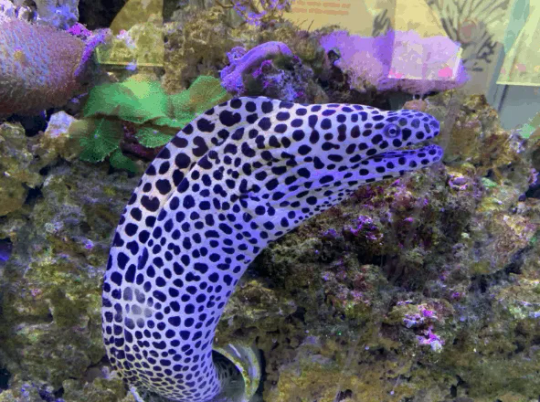

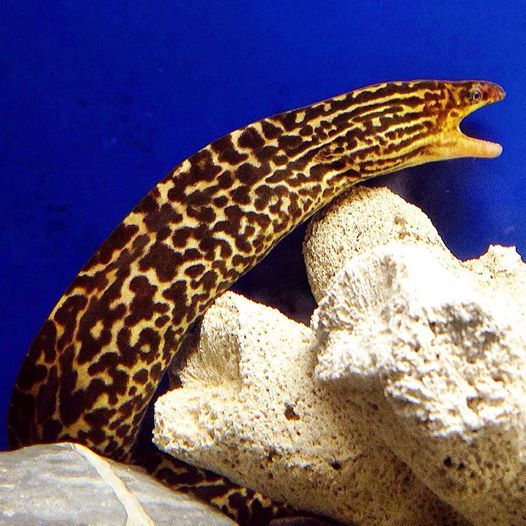


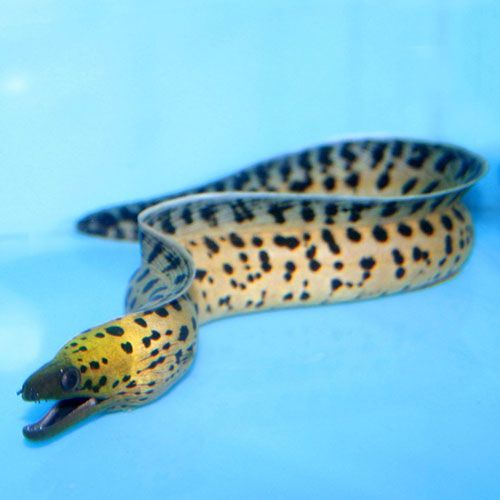
even the ones without fancy patterns have these adorable little faces. so lovable
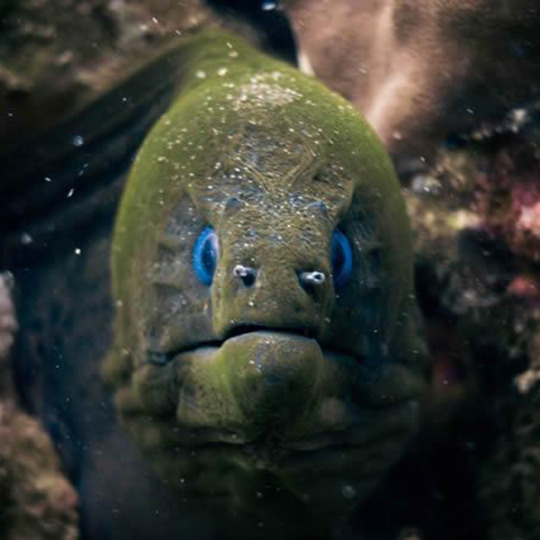

moray eel facts:
they have two sets of jaws, which inspired the xenomorphs' second mouth in the alien franchise
the largest species of moray eel, the giant moray, can grow around 10 feet long
the dwarf moray eel is the smallest and is around a foot long
the reason morays always have their mouths opening and closing is because they have no gill covers, this action forces water over their gills so they can breath
moray eels have no pectoral or pelvic fins, and their dorsal, caudal, and anal fins are fused like one long strip along the entire body
81 notes
·
View notes
Note
do U have a favorite fish?
MANY!!
*the only reason I won't include any cephalopods is bc they are technically mollusks and this post will prob be long as-is <o>
Scalloped hammerheads:
RAHHHHH SCALLOPED HAMMERHEADS <333 My favorite of hammerheads.

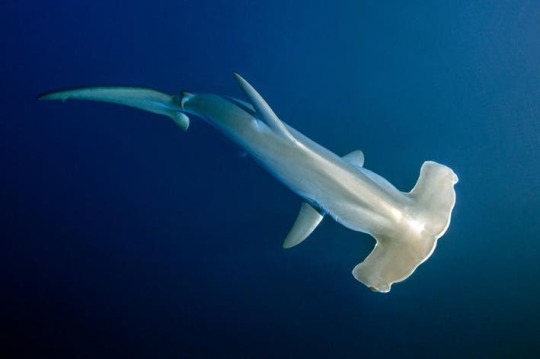
I love hammerheads in general for their look but something about scalloped hammerheads just....it's so good. They have my favorite head shape. Such a weird sentence.
They can live up to 30 years—females maturing at 15 years while males mature at 10—and weigh from 100-200 lbs (~45-90 kg). They typically grow to 6-12 ft (~2-4m). Big fishies!
Gestation periods normally last 8-12 months, and they give birth viviparously—so the eggs hatch inside the mother and are nourished in there until they're born.
Sadly though, like most hammerheads, scalloped hammerheads are considered critically endangered due to overfishing for their fins to make shark fin soup. It doesn't help that scalloped hammerheads are known to school with up to hundreds of their own, making many easier to be caught. Their reproduction is also too slow to repopulate the numbers that are missing. This is something that saddens me. Often. :')
But yeah, I love these sharks very dearly and am constantly hoping we get to learn more about their migratory patterns and other ways of life to further conservation efforts and keep 'em around.
(I had a scalloped hammerhead pin but i cannot find the beanie it's on for the life of me TT^TT but here is where i got it from.)
Several Eels:
EEEELS!! My slithery beloveds. Okay I'll choose uhhhh,,,4(ish!)
Moray eels - The poster children of eels! The most recognizable of 'em probably being the green moray eel.
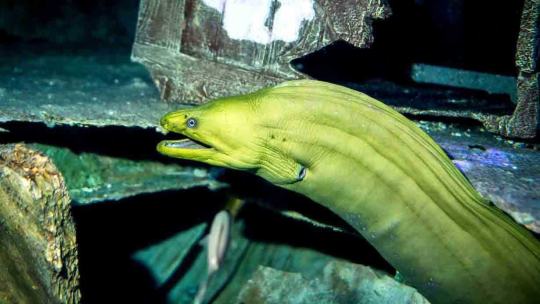
They like to hide in rocks and coral formations and are relatively shy, not often leaving their dens to swim in open water. They are around 6ft (~2m) in length on average, but the largest species (slender giant morays) can grow up to 12ft (~4m)!
Morays also have this neat set of teeth in their throat called Pharyngeal jaws. When they open their mouths to catch their food, these teeth reach forward to securely grab the prey and drag it back into their throats. Lovely!!
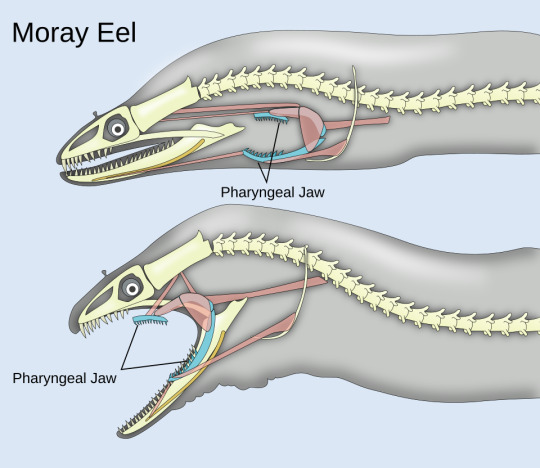
Anyways have this moray post as a bonus bc i love it and it's a favorite.
Ribbon eels - TRANS 👏 EELS 👏. Originally there were thought to be 3 different types of ribbon eels. Turns out though they're all the same, just at different stages in their life!

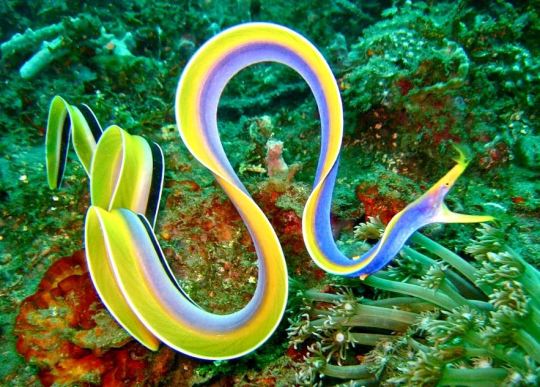
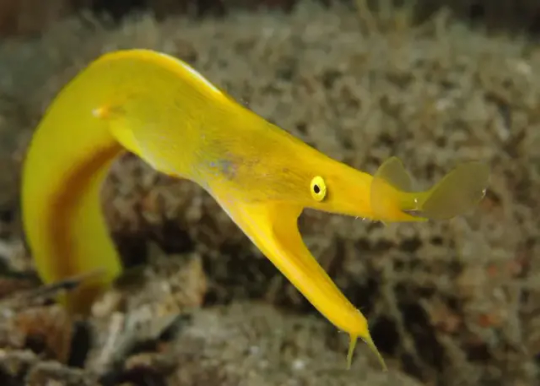
All ribbon eels are born male, where they are black and yellow. As they mature though, they start to gain that blue and yellow pallete and begin to develop female organs! By the time the ribbon eel is entirely matured, they are now female and entirely yellow.
They are technically also morays, but they get their own little spotlight for how fabulous they look :)
Electric eels - THEY AREN'T!! They aren't 'true' eels! They are actually a type of knifefish!!
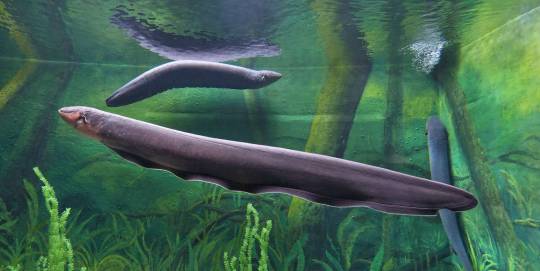
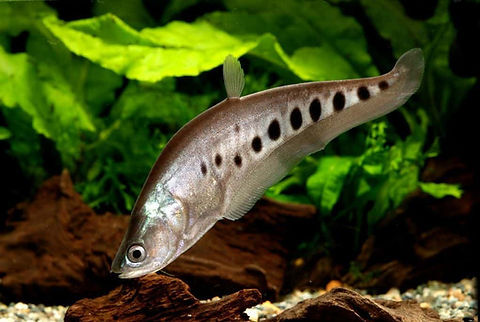
The first is an electric eel, and the second is a clown knife fish. They're called knife fish due to the lack of dorsal and caudal fins, only an extended anal fin on the underside of their bodies. Thus their shape! I'm still keeping the electric eel in this category though because it's cute and sneaky like that.
European conger eels - I love these dorks. So so much.
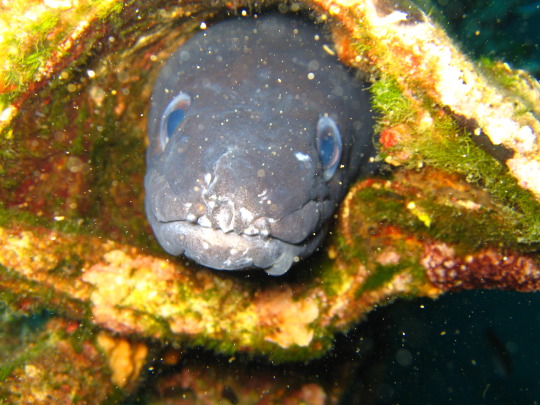
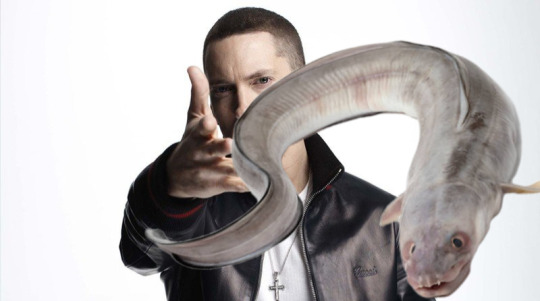
This no-thought-behind-its-eyes creature is the HEAVIEST EEL WE KNOW OF.
They can get up to 9 ft (~3m) long and the larger ones weigh up to 220 lbs (~100kg). 220 lbs of eel.
There may also be cases where they share dens with a lobster; the lobster will eat the conger's waste and extra food. But whenever the lobster molts and is vulnerable, the eel will typically just. Eat it. So. :/
Deep-sea sillies:
HAGFISH - I've held such a fascination towards hagfish since i first found out about them.
They are jawless fish. They still have a skull though. Oh but they have zero (0) vertebra? Of course.
When eaten, they coat themselves in icky slime that covers the attacker's gills to force the predator to spit them out.
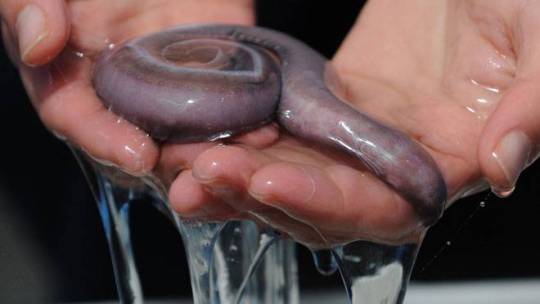
This goo can also backfire and suffocate themselves. So what do they do? Turn themselves into a knot to brush that shit off!
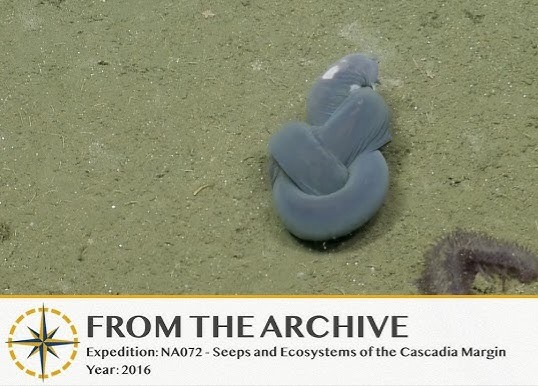
????
They also turn themselves into these knots so that when they bite into chunks of carcass—they're scavengers btw—they are able to use the knot as extra force to help them pull the meat off easier.
???? You do you, I guess??? Bonkers fish, love them. Moving on.
Snaketooth fish - huh

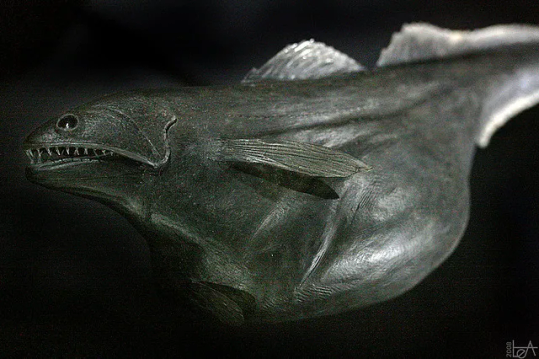
Yeah, that large bit of skin underneath it is its stomach. It. Its pelvic fins aren't fused together so its stomach can just streeeetch. This 10 inch (~25 cm) fish is able to eat other fish twice its size and 10x its own weight. And it swallows its food whole. Crazy? Uh.
Well they also die from this. They lack the ability to digest some of their larger meals in time before it starts to rot in their gut, causing the buildup of gases from its prey to just...rupture the snaketooth's own stomach. And inflate the now-dead fish into rising to the surface.
Phenomenally absurd and wild, like many fish that live in the twilight zone and deeper. 10/10. Marvelous.
That's all my goofs. Honorable mentions go to: oarfish, thresher sharks, and pelican eels. Ty for reading! :D
#Talk talk talk#Oughdg not an expert but i do love these fish....i hope i explained well enough#Long post#Fi...fish#If there are typos—nuh-uh#Answered
12 notes
·
View notes
Text
A speculative arboreal crocodylian
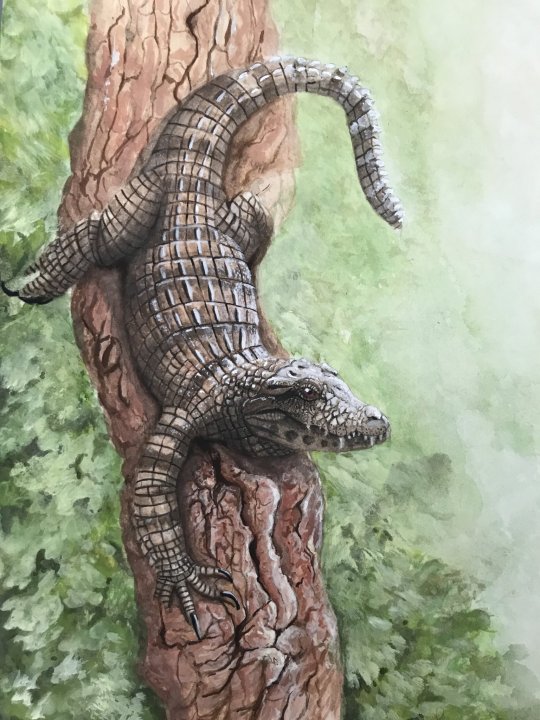
A year ago I began my research on the Mekosuchians, especially around the genus Mekosuchus and my already very strong skepticism at that time about the claims that they were tree-dwelling crocodiles (Something extremely improbable and which I may comment on another occasion. For now you can read in depth about Mekosuchus in this post by Armin).
At that point I wondered ; what would an arboreal crocodile really look like if it existed?
I decided that it would be a derived member of the subfamily Caimaninae, specifically belonging to the Jacarea clade (which includes all species of the genus Caiman and Melanosuchus).
The body has evolved in a convergentely with squamates such as Varanus salvator, being thinner and more elongated than that of any other crocodylian, following the same process the tail : Once the motor that propelled it underwater, is now becoming something similar to a whip that allows it to maintain balance on the branches, losing the characteristic single and double caudal crest whorls, to the point of almost disappearing.
The dorsal osteoderms are shrinking, but are still visible and play an important role in the ecology of the animal, helping it to thermoregulate.
The limbs have been considerably widened and strengthened, an adaptation very visible in the metatarsals of the hind legs, which, together with the sharp, curved claws they have developed, help the animal to cling effectively to trees.
The skull is the most distinctive part of all, as it has not only become shorter and more robust as a whole (Males have even developed an anteorbital crest similar to that of some members of the genus Crocodylus such as C. acutus or the extinct C. checchiai ; very likely some kind of sexual dimorphism), but it is developing unique characteristics such as binocular vision, zyphodont dentition and laterodorsally positioned nostrils, all of these attributes usually associated with terrestrial hunters (although there is not a necessary relationship in all cases), thus moving away from the semi-aquatic lifestyle.
Despite this, these crocodiles are still dependent on water to a certain extent, always inhabiting the forests near the rivers and being able to swim perfectly well if necessary, just like the extant iguanas and monitor lizards.
If I had to add some kind of worldbuilding that allows the existence of this animal, it would probably be located millions of years in the future : After a cataclysmic event related to climate change, South America has suffered a process of desertification in which large bodies of water have dried up, forcing the very abundant babas (Caiman crocodilus) to move into the remaining forests and jungles, adapting to a more terrestrial lifestyle. As an isolated population of these caimans chose the birds and monkeys as their preferred prey, they would gradually follow them to the treetops.
After a few more million years, the land has recovered, and large rivers and lakes are once again flooding South America, favoring the emergence of large tropical jungles again, opening a new world for these tree-dwelling caimans. Will they manage to adapt to the new climatic conditions or will they become extinct as a consequence of this and other factors such as the emergence of new species of placental predators that threaten to occupy their niche? Well, that is uncertain.
The illustration was made in gouache and watercolors during September 2022 . I scupted a small-basic figure made in clay to in order to facilitate the understanding of the lights and shadows.
Here are some pictures of the process:
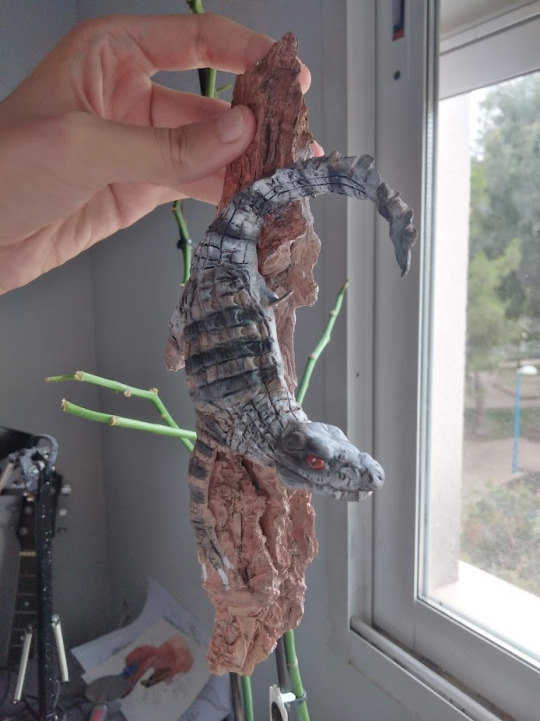
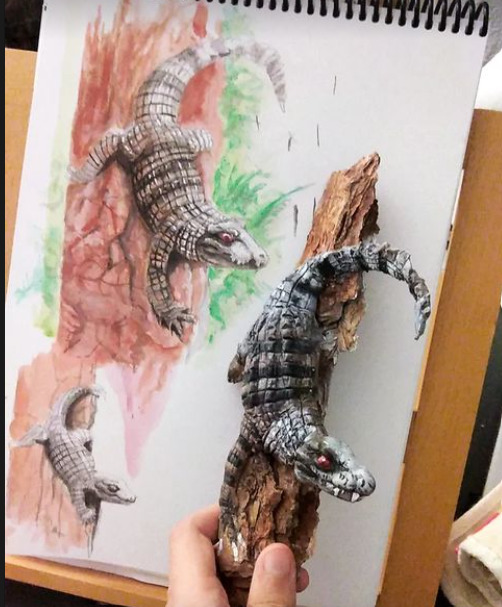
#animals#crocodiles#reptiles#zoology#crocodilians#paleoart#art#nature#speculative biology#speculative evolution#speculative zoology
278 notes
·
View notes
Text
Spectember D5: Sexual Selection
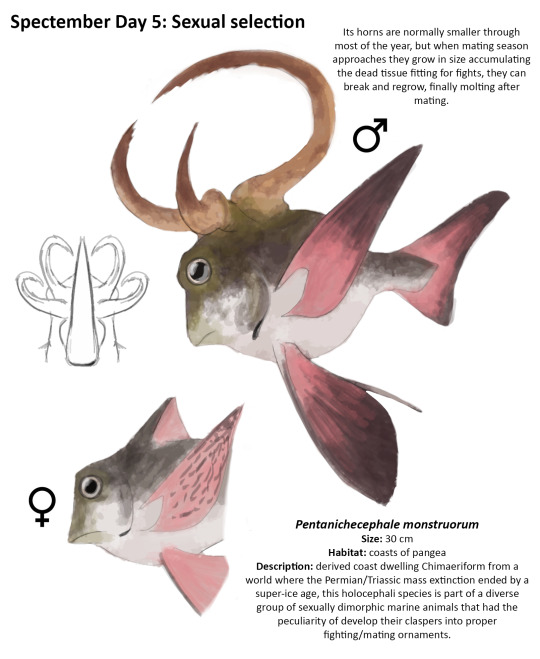
Through the different timelines, there is an alternative world that witnessed a deep ice age in the Permian caused by a prominent shift of the continent crust moving Pangea down into the south pole and blocking ocean currents, worsening the life conditions and turning most of the continent in a tundra, in the aftermath when the position of Pangea returned to something like its original position life was changed greatly, as unlike in our timeline earth was not suffocated in fire but got cold so a new variety of animals developed and survived.
In the oceans, Holocephali had a resurgence post Permian mega ice age, as their groups did not suffer horrible, things like Petalodontiforms, Eugeneodontids and other did not perish, but then there were other more varied forms evolving too, some sample are within Chimaeriforms which they in a better spot now that they aren’t relegated to the deep ocean but as diverse surface dwellers, some groups started to exploit their clasper structure in ways that would make them look almost unfitting for survival, this as a response of sexual selection. From there, a new group evolved, the Clasperantlers (Delirocephalia)
They are short body forms, small caudal fins but with large pectoral fins, these have the peculiarity that male claspers now have become these super elaborated ornamental structures that works mostly for exhibition or fight, depending of the species. They derive from ornamental structures around the orbits and the whole dorsal fin spine that developed into an articulated claw-like structure, something resembling the ornamental spines of Symmoriiformes but capable of movement.
The most common species is the Pentanichecephale monstruorum, small in size, about 30 cm in length, females look pretty much average to a chimaera with short tail, with a small dorsal fin, but the male in the other hand possess an ostentatious arrangement of 5 long horn-like structures, being 2 pairs growing around the orbit, with the middle 5th one the derived dorsal fin. They tend to be moderate in size but when mating season approaches, they start to grow in size, being covered in layers of dead tissue and useful against other males, they can break and regenerate, males often have to stand multiple fights before mating with a female which can hold with the 5th horn.
188 notes
·
View notes
Text
ok so like many people on here i'm very autistic abt fish (and other animals) so i'm gonna just start posting my notes app infodumps on the fish autism website
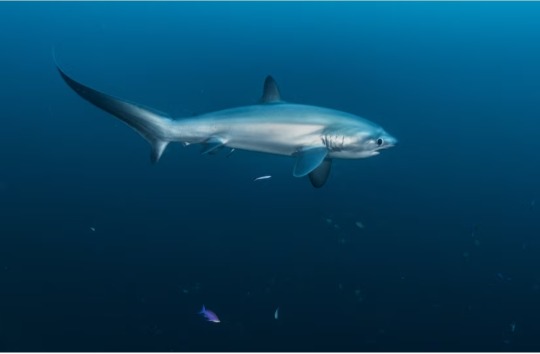
Definitely one of the goofiest sharks out there, i've gone on record as claiming the pelagic thresher (Alopias pelagicus) as my favorite shark. Threshers are known for their extremely long tail, which is used to help catch prey. The thresher uses its tail like a whip to stun groups of small fish. Points for creativity!
The pelagic thresher can be identified by dark patches of skin around the base of its fins and smaller eyes than its relatives. Perosnally, I would describe the species as looking like its mom just left it in line at the cash register to go grab something she forgot. Delightful lil guys!
Sources/further reading:
https://www.nationalgeographic.com/animals/fish/facts/pelagic-thresher
#i've gone back and forth on whether or not to post my infodumps like these for a while#hope ya like em#im making a tag for them#el's infodumps#my names el btw (shortening of my irl name)#pelagic thresher#thresher#shark#thresher shark
67 notes
·
View notes
Text
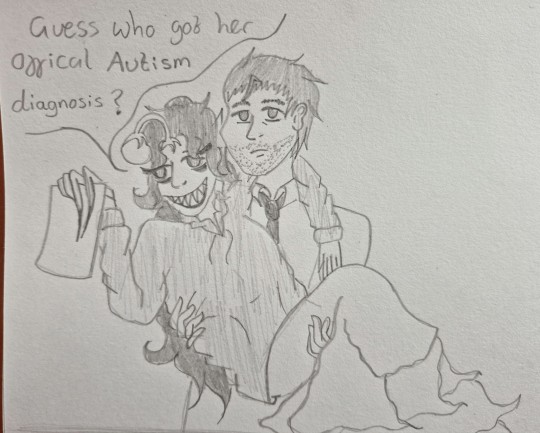
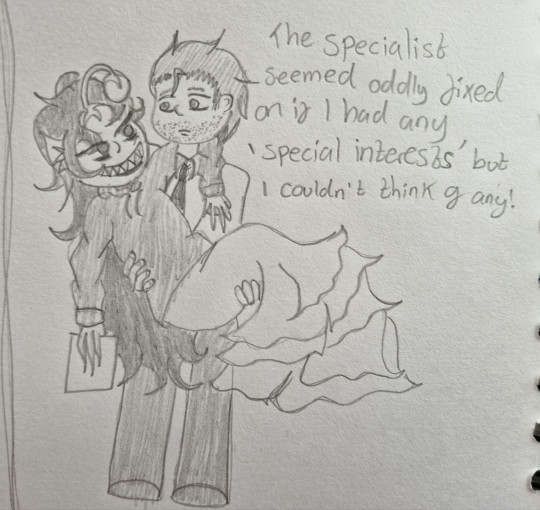

This fish is Autistic!
Hehe, this is a more personal post but yeah, got the official letter containing my diagnosis (that also got sent to my mysterious GP) today!! I got the oral diagnosis about a week ago but I wanted to wait until I had the letter.
The analysis sessions was nerve-wracking and I didn't sleep at all before each one! However yeah, the first specialist I spoke to seemed to keep circling back to if I had any special interests during some of her questions and I panicked cuz I couldn't think of any and I was like "oh no I'm wasting her time why did I agree to this?!" - then once I was home and more calm I was like "huh... I suppose there's one thing that I've basically made my online personality... that one thing I'm annoying about..." xD
But yea, at least I got answers now! I have no idea what the numbers and such mean on my letter but I'm meeting friends next week that I can tell this to!
Leg reveal! I gave myself caudal fins similar to that of a betta fish - and also why do you think I made Ogawa so big and strong? ... so he can carry me outside my fish tank! xD
Also one of the pictures is my collector's edition of Death Mark, one of my most treasured possessions!
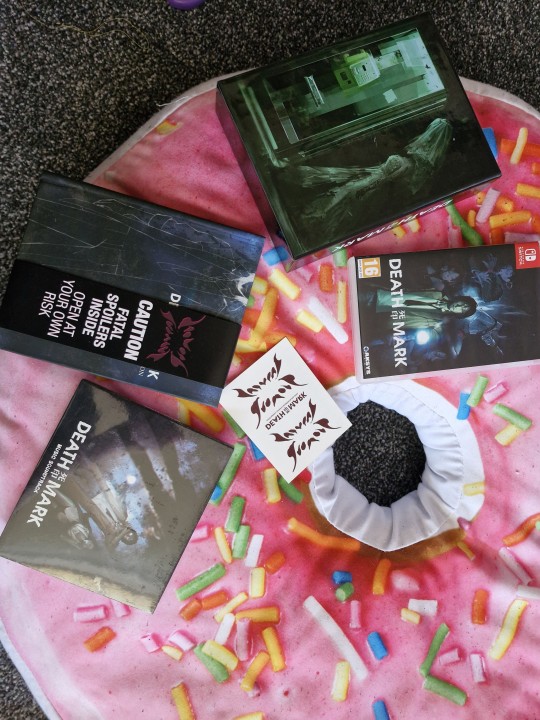
#i even made my diagnosis about death mark#but no special interests here!#personal#doodles#autism#taro ogawa#death mark#spirit hunter#shiin#spirit hunter death mark
8 notes
·
View notes
Text
sonic every now and then:

#sonic the hedgehog#sonic#sth#sonic forces#sonic frontiers#sonic prime#infinite the jackal#sage the ai#sonic sage#sage sonic#shatterverse#caudal posts
539 notes
·
View notes
Text
## LEVEL 3 ; THALASSOPHOBIA
>>> Two Time (Forsaken) / Rekrap (Lifesteal) Mixtive
Requested by ; N/A, self indulgent.
There's something in the water...

LEVEL 1 ; POOLROOMS
Name : Caudal , Gecko , Dagger , Revival , Resurge , Dirk , Blunt , Ritual
Pronouns : Hy/Hym , Thxy/Thxm , Shy/Hyr , ?/? , !t/!ts , Watch/Watches , See/Sees , Fear/Fears , Para/Noia/Paranoias , Drop/Drop , Bare/Bare , Attack/Attack , Mut/Mutilation , Blade/Blade , Sneer/Sneer , Bleed/Bleeds , Vio/Violent , Gut/Gutz ,🦎/🦎s , 👁️/👁️s , 🩸/🩸s , 🗡️/🗡️s
Age : 19 - 20
Orientation : Paranoidromantic , Aromantic , Asexual
Gender : Non-binary , PPDthing , Genderfluid
Species : Robloxian , Lizard Hybrid
Roles : Paranoia Holder , Serpent , Prosecutor , PPD Holder , Isolator
Source(s) : Forsaken , Lifesteal SMP

LEVEL 2 ; DIVING SUIT
Likes : Branzy , Playing source (Forsaken) , Escape rooms , Puzzle games , Roblox , Being with loved ones , Lifesteal members / sourcemates , Making AUs , The woods
Dislikes : Strangers / strangers interacting with hym , Getting lost , Loved ones being upset , Losing , Open spaces
Fronting Triggers : Strong feelings of fear / paranoia / anxiety , Source , Talk about Spawn , Music shy likes
Typing Quirk : Replaces S with Z. Short / one-word answers. Typically very proper.
>>> ex: The quick brown fox jumpz over the lazy dog. Fine. Zure. That'z okay. No thank you.
Basic Personality : Cautious , Judgmental , Aggressive , Caring , Protective
Faceclaim : [1] ★ [2] ★ [3]
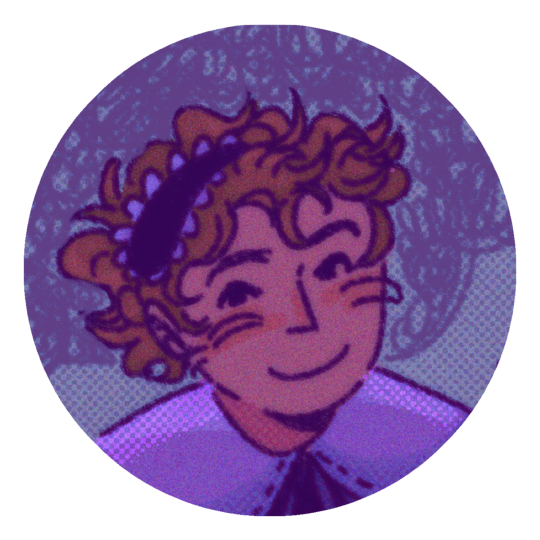

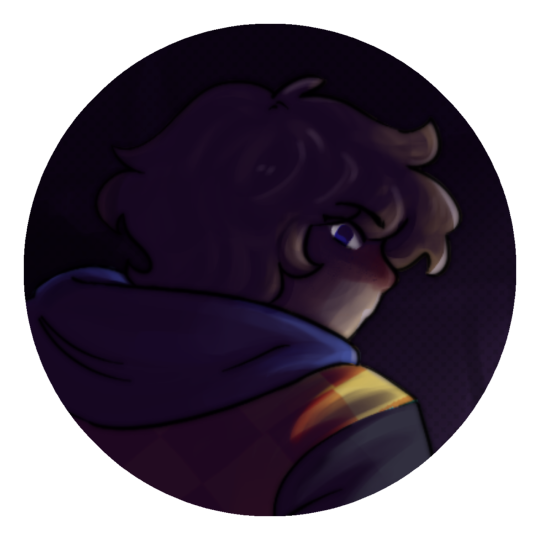

LEVEL 3 ; THALASSOPHOBIA
Detailed Personality : Caudal is someone who is often consumed by hys paranoia and grudges. This can lead !t to lashing out at people. Especially those outside of the system. At times, ? will go silent on all social medias or block people mut considers a threat. Gut will judge others and considering them as threats without a second thought and will refuse to budge on the idea. Can often be sarcastic and snippy with people unintentionally. Watch cares deeply for the ones hy loves though, and often worries for them, checking on them often. Prefers to front or co-con with other members silently, so 🦎 can step in if needed.
Song(s) and / or associated musician(s) : spy? by WHOKILLEDXIX , I duckinf hatw you by Ghostemane & Parv0 , The Crane Wives
Aesthetic(s) : (Old) Graveyards , Cryptidcore




ADD-ONS ; ABYSSAL
Hyperfixations : Forsaken , Pressure , Cryptids
Special Interests : Cults , Blade foraging , Animals
Kins : Jackalope Therian

First post... Anyway, this was purely made to help a part gain an identity. Pretty fun to do! :}}

Credits ; [Top Divider] ★ [Water Dividers] ★ [Bottom Divider]
#⟩ Level 3 ; Thalassophobia#⟩ Unlocked Combiner#⟩ Source ; Lifesteal SMP#⟩ Source ; Forsaken#bah#baa#build a headmate#build an alter#alter creation#headmate creation#pro endo
9 notes
·
View notes
Text
I apologize for such a long delay. I couldn't find the motivation to keep posting here. But, as I promised in my last post, here are three more drawings made for last year's scientific conference. :)

Front half of Dakosaurus andiniensis, massive metriorhynchid from Late Jurassic of Argentina. As with Cricosaurus, I based this reconstruction on metriorhynchid specimens with skin. Note the presence of speculative skin parasites, whose marks were founds in fossil skin. Also, there are salt glands in antorbital fenestra. This feature is based on this study: https://anatomypubs.onlinelibrary.wiley.com/doi/10.1002/ar.24678 BTW, some recons portray Dakosaurus with crocodile-like facial integument and some recons even have "lips"! I decided to diversify from these both options and did it with smooth streamlined skin.
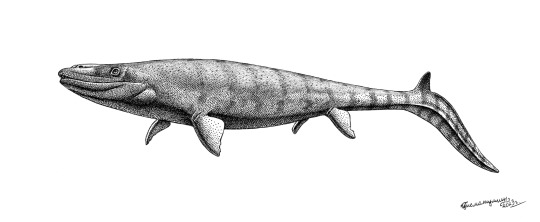
Prognathodon sp. reconstruction based on purportedly juvenile specimen with soft tissue outlines from Late Cretaceous of Jordan. This small individual was described in this paper: https://www.nature.com/articles/ncomms3423 Preserved skin impressions include silhouettes of the skin fringes of the flippers and the caudal fin. The caudal fin is quite small, but in adults it could be proportionally larger. This finding confirmed that mosasaurs converged with ichthyosaurs and metriorhynchids to develop a fish-like caudal fin.
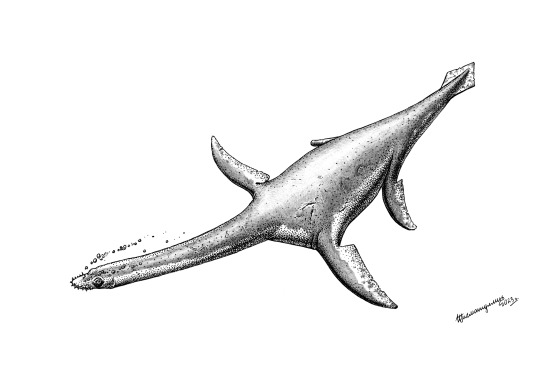
And finally, Seeleyosaurus guilelmiimperatoris (formerly species of Plesiosaurus), a microcleidid plesiosaur from Early Jurassic of Germany. Holotype of this species is almost complete specimens with some skin impressions including rhomboidal skin flap. Perhaps all plesiosaurs had caudal fins of one form or another. However, their orientation is controversial: many paleontologists are of the opinion that the fin was vertical, but others think it was horizontal.The arguments in favor of the second point of view are the rigidity of the chest, the flat and wide shape of the tail in the proximal part and the absence of bending in the distal part of the tail: https://www.researchgate.net/publication/339423536_Peculiarities_of_the_Structure_and_Locomotor_Function_of_the_Tail_in_Sauropterygia I decided to choose this version for reconstruction. Which of the scientists is closer to the truth, new findings will show. All of these drawings were done with black gel ink pen and black colored pencil with small additions of white gouache.
#dakosaurus andiniensis#dakosaurus#metriorhynchidae#thalattosuchia#prognathodon#mosasaur#seeleyosaurus#plesiosaurus#plesiosaur#sauropterygia#marine reptile#paleoart
27 notes
·
View notes
Text
Fun fact brought to you by a marine biologist/marine affairs major!
Part 3: Creature from the Black Lagoon Edition!
Sooooo I ended up getting her and when I finally got to look at her details up close, I got inspired to do another one of these! Now that I’m graduated, I’ll most likely be taking her out of the box at some point! This will also be a little bit of a review too!
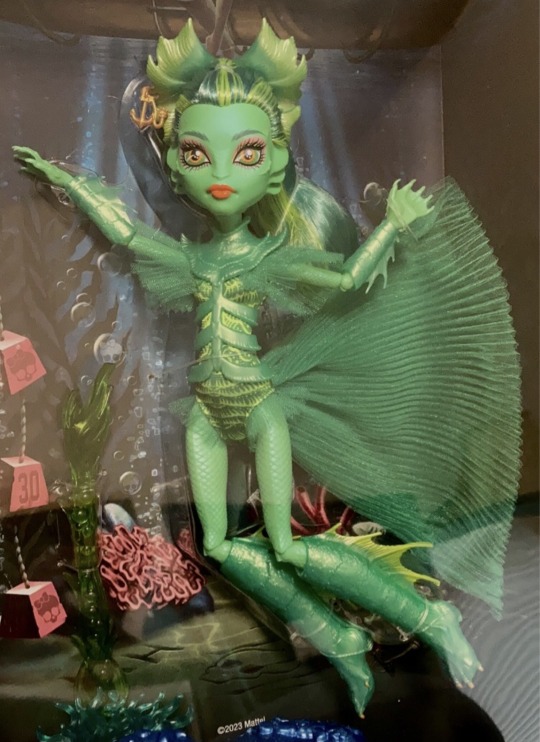
In my previous post, I rated her a 9.7/10 because I was confused by some design choices, like the harpoons in her heels. I feel that would’ve looked better with some type of shoe unless her feet are supposed to be like boots? Anyways, I’ll be going from head to feet with aquatic biology and my feedback!
The Fin Headpiece:

Most fins have multiple lines or filaments like that and tend to start with either a darker color or color that matches their body on the inside. That color starts to fade out the further on the fin we go because the material is a lot thinner. They can appear to have a sheen look sometimes because they can be shiny and reflect light a little!
The Face:
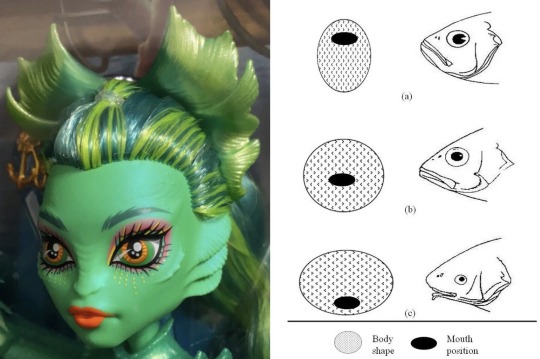
Probably the most informative part, the face has many qualities to it! Makeup? Iconic. Flawless. The only thing I might change about it is maybe a not-as-bright lip color, but I think I feel that way about many designs and might just be a personal preference so I’ll let it slide. Aquatic factors? To. The. MAX!
Unless a fish has a protruding lower jaw, they don’t typically have an upturned smile. Body shape and mouth position can be linked together too. Bottom feeders, like catfish and sturgeon, are usually wider and flatter with an inferior mouth or a mouth that’s toward the bottom of their face or completely under it. Fish with superior mouth types (“a” in the picture and towards the top of the body) and terminal (“b” and towards the middle). As you can see, either way, the fish will have a downturned mouth and I just love that quality on this doll. This follows with her nose as well! Her nose does stick out like a normal monster high doll. It’s flattened a bit and has wider nostril sides which goes along with the snout on fish.
Now, I know most of her design is literally based on the Creature of the Black Lagoon so I’m probably just listing facts about him too, but let’s talk about the sides of her face, the part I highlighted the most in this 3/4 perspective!

Probably the most prominent features on her head sculpt: Gills! They generally follow the rules of anatomy having the the arches and filaments, but she is missing an operculum, which is a protective covering for the gills made by a series of bones. This doesn’t mean she’s entirely inaccurate though as only bony fish have operculums!
The Hands:
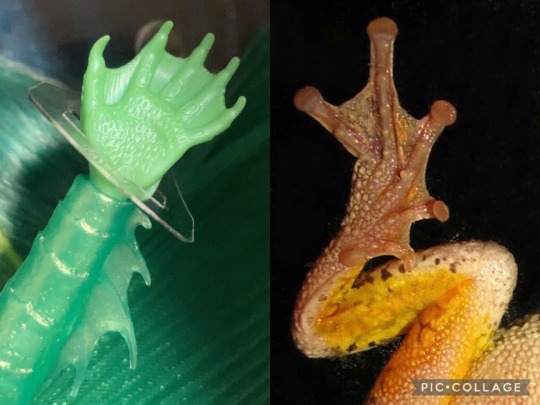
While it isn’t related to fish much, I wanted to admire her hands too! On Mattel’s page for her, they mentioned amphibious a couple of times so I thought I should show that. This is a comparison to frogs hind leg and foot (I couldn’t find a good picture of a “hand” or front leg).
The Body/Clothes:
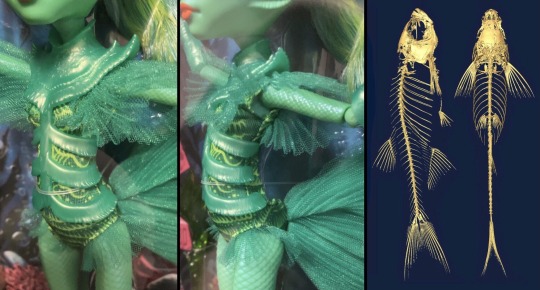
As mentioned above, this piece was called “Pearlescent amphibious body armor” and while it does resemble a frog-like skeleton a bit, I felt it looked more like a fish! The top part that rests on her shoulder reminds me of the head portion of the skeleton.
Now, let’s take a look at her tail/fin which I believe is made of some type of tulle, but please correct me if I’m wrong! I don’t know much about fabrics.

The way the tulle sticks out in the first set of body pictures (middle one) reminds me of a caudal peduncle which as described in the picture above, connects the main body and the caudal (tail). The way the tulle is spread, it looks like it would be a truncate tail. Tail shapes are connected to the maneuverability and speed of a fish and each in the third picture shows how they could work. I know it probably doesn’t lay that way when she’s taken out of the box, but it was a cool design choice!
The Feet/Shoes:
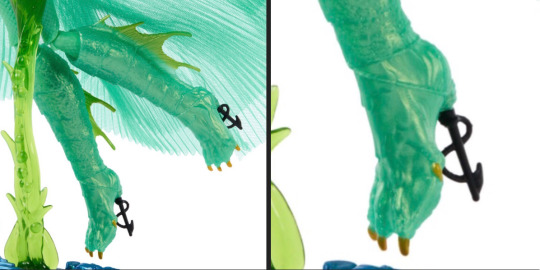
I haven’t taken her out of the box yet, meaning I don’t have any good pictures of her feet or the stand so I’m using the stock photos from Mattel’s site. The fins follow fish biology with them being a lighter or different color and the tops and bottom of her feet/shoes resemble a more amphibious or reptilian nature. Taking a closer look at it, I can now see that the harpoon is attached to a rope that wraps around her ankles! I wish they colored it differently so we could distinguish that (or maybe I was the only one who thought they just stuck harpoons in her heels lol). After finding that out, I don’t have much complaints. I think it’s kind of cool they made the feet into boots!
The Stand:
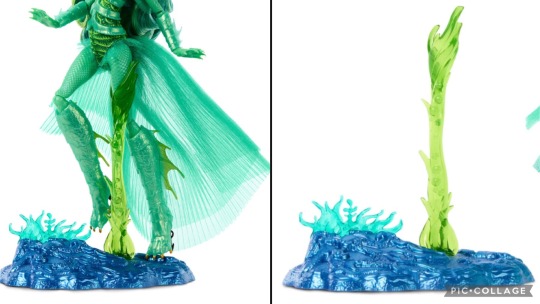
I adore the stand! I love when stands can add a bit of background or a pop of color to the doll! The kelp/seaweed was a great idea to hold her up and there’s detail on the sea floor as well! My only tiff is that I don’t quite know how stable this will be. With the usual stands, the clamp in the back holds their waist up while the bottom gives their feet something to rest on. It makes it stable in general posing of dolls. These pictures show her feet barely resting on it and I’m sure you could probably stretch her one foot out to land on the higher part of the terrain, but it wouldn’t quite look as good as the stock.
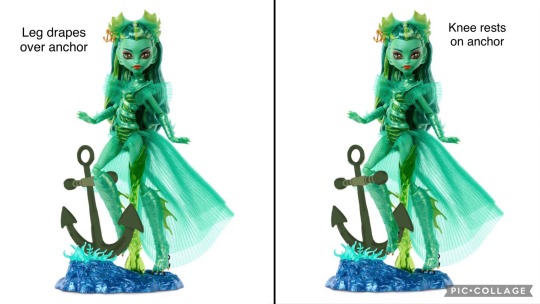
I tried making a quick edit of another way to keep the pose. I originally wanted it to be a harpoon and harpoon gun but I felt that was sort of off brand with Mattel and Monster High so I instead lifted that anchor from the terrain, colored it differently to look like it was covered in algae, and rested it in the seagrass! The only drawback would be that it requires a bit more plastic for each stand and may make it a little more clunky. Like I said, I haven’t taken her out of the box yet so I don’t quite know how stable the original stand is, so this is more so brainstorming!
Overall:
Making this post made me glad I got her and appreciate her design more. I got her about a month before graduating and it seemed fitting for my final doll delivered at college to be one that’s similar to my major (er I guess I should start saying degree now huh 😅)! I know this was such a long post and I’m sorry for it but I figured combining my “Fun Fact” series and an observational review of her in-person would be great! Her rating still stands at a 9.7/10!
What do you guys think? Do you like her design? What’s your favorite or least favorite part? What would you change about her? Should I keep doing this series??
#monster high#monster high art#monster high design#monster high edit#draculaura#frankie stein#lagoona blue#ghoulia yelps#monster high lagoona#monster high oc#mh skullector#monster high dolls#monster high skullector#mh fanart#skullector#mh creature from the black lagoon#creature from the black lagoon#fang club#mh fang club#monster high fanart#monster high fandom#mh collector#monster high collector#mh edit
50 notes
·
View notes
Text
Fossil Friday: Nuucichthys rhynchocephalus

Bet you've never heard of this little guy. That's because it's brand new to science! Nuucichthys was found in the Marjum Formation in Utah. It is a stem-vertebrate, which, if we recall from last month, means that it is just below vertebrate proper in the family tree.

It is characterized by a finless torpedo-shaped body that includes a snout-like anterior head bearing anterolateral eyes, approximately 25 thick myomeres, a large branchial chamber with a keel and approximately seven putative dorsal bars and a spiniform caudal process.
Curious to learn more? You can either check out the paper here:
And/or you can come to my tiktok channel on Sunday, December 8 and see a live discussion on it with me and some of my colleagues at 5pm MST.
This Sunday, December 1, my colleagues and I will be doing a discussion on the Homotherium cub found in Siberia that I talked about last week. Hope to see you there!
It will be posted on my Patreon later so if you can't make it, you can find it there!
#paleontology#fossils#science#science education#geology#new discoveries#stem vertebrate#chordates#chordata
15 notes
·
View notes